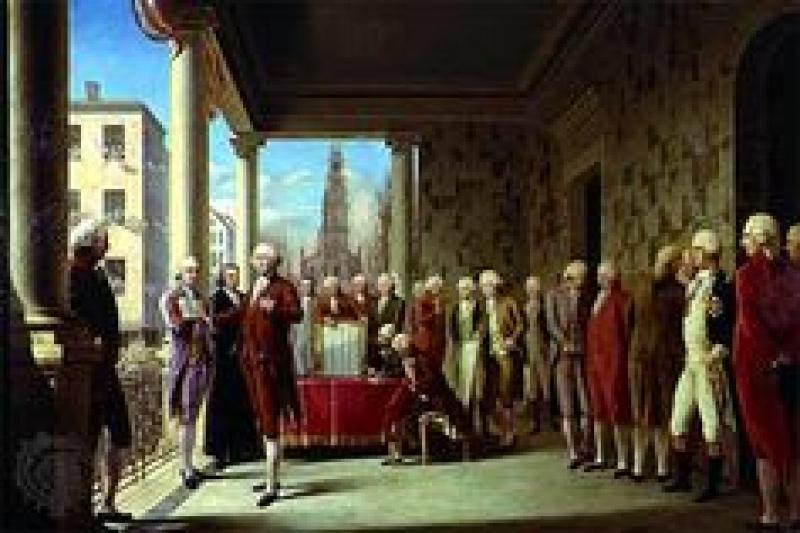A third term for the Clintons?
David Stebenne's latest article on The Conversation (published here under CC by nd):

The Democratic Party’s nomination of Hillary Clinton this past week has revived an old controversy in a new way: presidential third terms.
It is a controversy as old as the nation itself.
The father of the nation sets a precedent
The third term issue first surfaced during George Washington’s second presidential term, which ran from March 4, 1793 to March 4, 1797.

Making that problem even more serious was Franklin Roosevelt’s patently obvious enthusiasm for a strong presidency. For a president like him to seek a third term in 1940 raised the specter of a president for life, at least in the minds of his conservative opponents.
Also concerning his opponents was the pattern of leaders-for-life that had emerged by then in the major fascist and communist countries: Germany, Italy and the Soviet Union. Doing something that made Roosevelt look like Hitler, Mussolini and Stalin aroused even more opposition.
Indeed, no single action of Franklin Roosevelt’s long presidency horrified strongly conservative people more than his decision in the spring of 1940 to run again. As contender Wendell Willkie put it in his acceptance speech at the GOP convention:
“I should like to debate the question of the assumption by this President, in seeking a third term, of a greater public confidence than was accorded to our presidential giants, Washington, Jefferson, Jackson, Lincoln, Cleveland, Theodore Roosevelt and Woodrow Wilson.”
His opponents interpreted Roosevelt’s action as reflecting his intention to remain president for the rest of life. Even though that apparently overstated FDR’s desires, it is nonetheless true that president he would remain until the day he died.
There was truth on both sides of that particular third-term argument. Doing the job for another four years didn’t kill Roosevelt, but the stress and strain nonetheless greatly harmed his health. And because the war was not over by 1944, he felt obliged to run again, and died in office only three months after his fourth term began.
Given all these good reasons not to elect FDR to a third term, why, one may reasonably ask, did voters do it?
There were three decisive and related factors.
One, FDR’s much greater experience in national security matters than his opponent, New York businessman and novice politician Wendell Willkie. Two, the perilous foreign policy situation at the time. And, three, an improving American economy.
If Gallup surveys are to be believed, swing voters in 1940 thought that putting a completely inexperienced commander-in-chief into the White House on January 20, 1941 was simply too risky, given the dangers the U.S. faced from abroad by Election Day in November 1940.
The American military buildup that year in response to those events also drove down unemployment steadily in the summer and fall of 1940, undercutting Willkie’s critique of the New Deal as economically unsuccessful. And by 1944, when FDR sought a fourth term, Depression-era economic conditions had vanished completely, something that helped carry him to victory.
Franklin Roosevelt’s inaugural address, 1941. Library of Congress
By winning an unprecedented third and fourth term and then dying in office, FDR posthumously provoked Congress and the states to constitutionalize a two-term limit, by adding the 22nd Amendment to the Constitution in 1951.
It is worth noting that by barring not just a third term but also more than 10 years of service in the presidency, the 22nd Amendment also essentially prohibited another effort like Theodore Roosevelt’s in 1912.
2016
All of this helps put the current presidential election in better perspective.
The two-terms-and-no-more tradition, now constitutionalized, has tended to increase resistance to a Hillary Clinton presidency. While we are inclined to think of former Secretary Clinton as a politician in her own right, arguably, she and her husband, Bill, have always been a team.
As Bill Clinton said on the 1992 presidential campaign trail, with Hillary as first lady Americans would get “two for the price of one.” Hillary is now offering the same two-for-one package this time, complete with promises that Bill will be placed in charge of revitalizing the economy.
And so the Hillary Clinton presidential bid of 2016 has raised the prospect of a different kind of third term: a nonconsecutive one in which the junior partner from the first two terms becomes the senior one in the third (and, quite possibly, the fourth).
If history is any guide, what would make such a third term acceptable is the vastly greater national security experience of Team Clinton compared with their general election adversary, New York businessman and novice politician Donald Trump.
That factor may well combine with growing dangers from abroad and an improving economy at home to put the Clintons back in the White House.
And so even though resistance to a third presidential term is as old as the office itself and has been formalized by the 22nd Amendment’s adoption, the possibility remains in some ways alive, and as controversial as ever.
